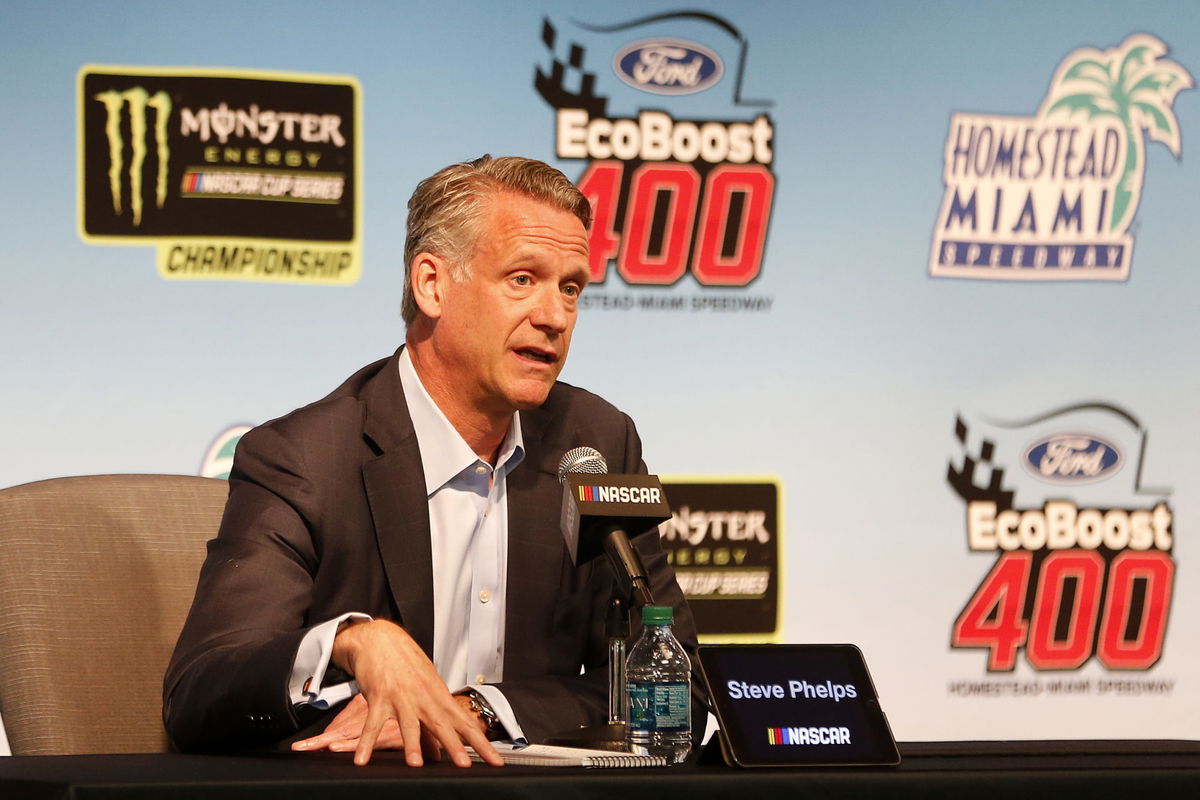
Getty
HOMESTEAD, FLORIDA – NOVEMBER 17: NASCAR President Steve Phelps speaks to the media prior to the Monster Energy NASCAR Cup Series Ford EcoBoost 400 at Homestead Speedway on November 17, 2019 in Homestead, Florida. (Photo by Brian Lawdermilk/Getty Images)

Getty
HOMESTEAD, FLORIDA – NOVEMBER 17: NASCAR President Steve Phelps speaks to the media prior to the Monster Energy NASCAR Cup Series Ford EcoBoost 400 at Homestead Speedway on November 17, 2019 in Homestead, Florida. (Photo by Brian Lawdermilk/Getty Images)
NASCAR’s 2024 season had everything. Thrilling races, a nail-biting playoff series, and a third Cup Series championship for Joey Logano, which felt ripped from the pages of a Hollywood script. Yet, a treasure trove of controversy simmered just beneath the surface, threatening to overshadow the excitement. At the heart of one drama was NASCAR’s Damaged Vehicle Policy (DVP), a system designed to ensure safety and competition but which instead left drivers, teams, and fans frustrated. The policy’s execution raised questions about consistency and fairness, with some claiming it even impacted championship outcomes.
Watch What’s Trending Now!
In a year-end interview with The Athletic, NASCAR President Steve Phelps defended the policy’s enforcement while acknowledging room for improvement. However, his comments stopped short of admitting any missteps, setting the stage for an offseason of debate.
ADVERTISEMENT
Article continues below this ad
Phelps squashes ‘inconsistency’ allegations
Few topics in NASCAR sparked as much debate this year as the DVP. Designed to prevent severely damaged cars from re-entering races, the policy imposes strict rules: cars must meet minimum speed after repairs, and those towed directly to the garage are automatically disqualified. But while the intentions were clear, the execution was anything but.
In his interview, Steve Phelps was unwavering in his defense of the DVP’s enforcement. “My answer to that is there are no such things as do-overs,” he said when asked if there were decisions he wished NASCAR could redo. “Our guys looking back, I think they would tell you, ‘Hey, there’s nothing that we did that wasn’t consistent with what the rules say we should be doing.’”
ADVERTISEMENT
Article continues below this ad
However, Phelps did acknowledge that the policy’s implementation might have caused confusion. “There might have been some confusion relative to the competitors of what was happening, but I don’t think our guys felt that they got any of that wrong,” he said. Phelps admitted that the system will be reviewed in the offseason. “That’s something we’ll look at and potentially tweak heading into ’25.”
NASCAR’s Senior Vice President of Competition, Elton Sawyer, echoed Phelps’ sentiment. Speaking to NASCAR.com, Sawyer explained that decisions at Talladega were influenced by lessons learned from earlier controversies, such as Berry’s disqualification at Kansas. “Our goal was never to put good cars out of the race,” Sawyer said. “Last week, we looked at [Kansas] and thought maybe we should have made a different call. At Talladega, we wanted to err on the side of the competitors.”
But that pivot itself raised questions. Denny Hamlin, a vocal critic, accused NASCAR of inconsistency. “You can’t change your mindset in the middle of the playoffs,” he said on his podcast Actions Detrimental. “You made a rule, stick to the rule.”
ADVERTISEMENT
Article continues below this ad
DVP debacles: Frustration on the front lines
The controversy reached a boiling point during the 2024 playoff race at Talladega, where a record-breaking 28-car pileup left drivers stranded. Some, like Chase Briscoe and Chase Elliott, were towed to the pits and allowed to continue. Others, like Josh Berry, were left fuming after being forced out of contention in similar circumstances earlier in the season. The inconsistency did not go unnoticed.
After the race, Joey Logano called the scene “comical.” “I get out of the car and see just a bunch of cars after a red flag, we’ve been sitting there 10 minutes, everyone is hoping they can roll a little bit. It’s just goofy.” Briscoe echoed the confusion, describing conflicting instructions from officials during the red flag period. “Inside the car, the officials are doing their job, but they’re telling you one thing, and your team is hearing something else,” he said. “It’s very confusing.”
The issues are rooted in a combination of factors. The current-generation Cup cars lack inner liners in their tires, making them more prone to becoming stranded with flats. NASCAR’s attempts to remedy this, including introducing air jack systems, have proven inadequate. At Talladega, even the air jacks didn’t work for some cars, leaving drivers frustrated as their playoff hopes hung in the balance.
This wasn’t the first time the DVP drew ire in 2024. Earlier in the season, Berry was eliminated at Kansas after a minor spin left his car stranded with flat tires. Despite minimal damage, he was towed to the garage, ending his day. Reflecting on the Talladega chaos, Berry was livid: “Get towed to pit road, buddy, because that would be breaking the Damaged Vehicle Policy,” he said. “The [No. 42 car] is over there doing burnouts, but if you have four flat tires and get towed, you’re done? It’s ridiculous.”
Phelps and Sawyer’s comments suggest a willingness to adapt, but significant challenges remain. Will playoff drivers receive preferential treatment? How can officials ensure consistency in high-pressure situations? These are the questions NASCAR must answer as it prepares for the 2025 season.
The DVP, while well-intentioned, has become a flashpoint for criticism. As Phelps himself noted, “fine-tuning” is an ongoing process in NASCAR’s ever-evolving rulebook. Whether those tweaks will be enough to restore faith in the system remains to be seen. One thing is certain: the offseason promises to be as contentious as the preceding season.
ADVERTISEMENT
ADVERTISEMENT
ADVERTISEMENT
ADVERTISEMENT


